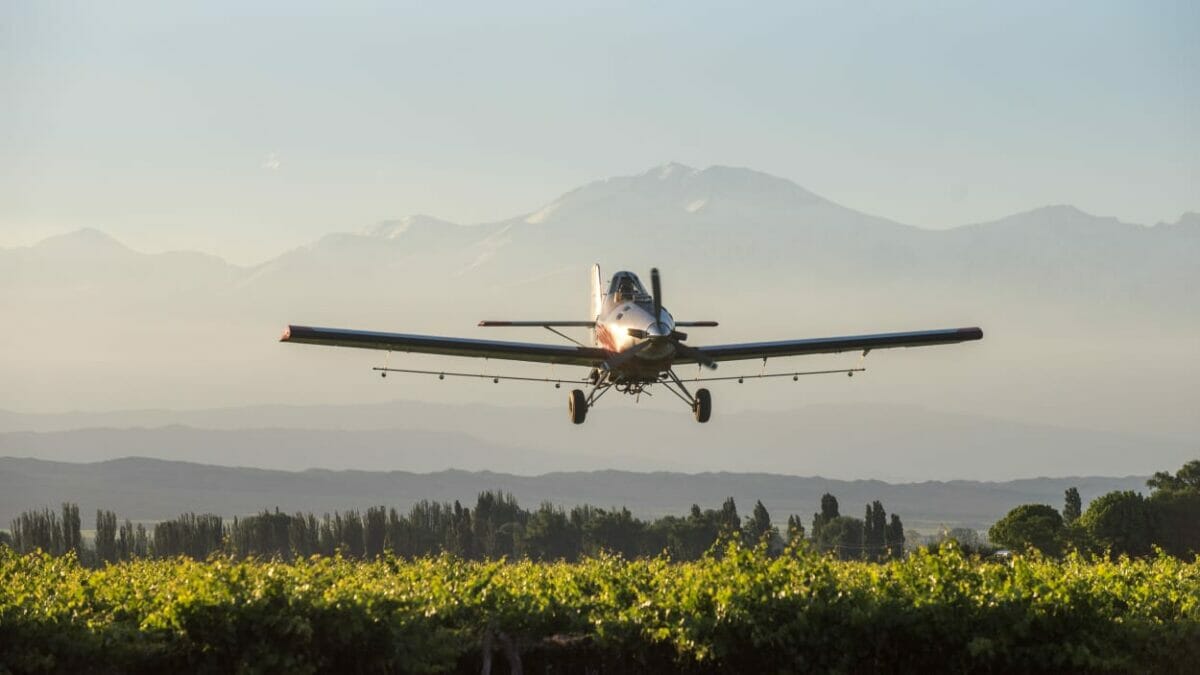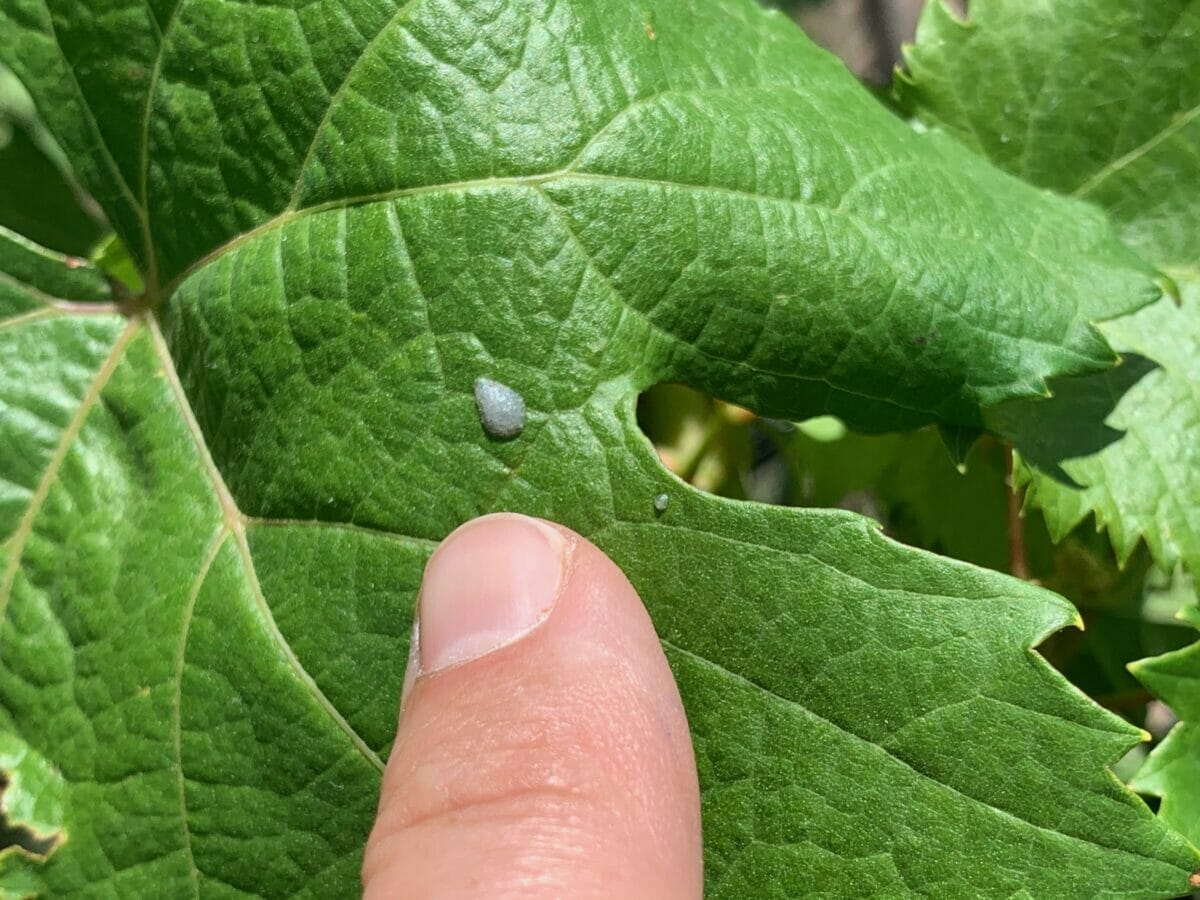How Insect Sex Pheromones Are Saving Argentina’s Wine Industry
The grapevine moth flocked to South American vineyards more than a decade ago. Now, wineries are utilizing a sustainable method of mating disruption to get rid of them.
How Insect Sex Pheromones Are Saving Argentina’s Wine Industry
The grapevine moth flocked to South American vineyards more than a decade ago. Now, wineries are utilizing a sustainable method of mating disruption to get rid of them.

Argentinian vineyards are spraying a liquid, non-toxic pheromone called SPLAT Lobesia on their vines to stop grapevine moths from reproducing.courtesy of ISCA Inc.
In 2008, a new pest appeared in South American vineyards for the first time. The European grapevine moth, Lobesia botrana, was detected in Chile and soon after spread to Argentina, where it affected at least 30 percent of vineyards.
The grapevine moth, which can feed on either flower or fruit, is a serious threat. If the moth attacks mature grape clusters, the berries can become further damaged or infected with a fungus called botrytis, leading to a reduced grape harvest, drop in wine production and, ultimately, major profit loss.
Argentina, the fifth largest wine-producing nation in the world, recognized the risk immediately. In 2011, the country declared a “phytosanitary emergency” in order to get the grapevine moth problem under control and keep it from spreading from Mendoza—world renowned for its Malbec wines and home to more than 356,000 acres of vineyards—to other nearby wine regions.
At Santa Julia Vineyards, vineyard manager Edgardo Consoli quickly implemented a treatment that utilizes the use of artificial pheromones, which replicate the sex hormones released by female moths that enable males to locate them more easily.
At the beginning of spring, Consoli hangs pheromone dispensers, which are applied by hand, throughout the vineyards—a method that’s been used to protect European vineyards in Italy, Germany and France for decades. The dispensers are made of a porous plastic that slowly releases the pheromone over many months. When the males follow the scent, they’re tricked into flying to areas where there aren’t actually any females to mate with, preventing them from producing more offspring and, therefore, protecting the vineyards from future pests. This strategy of mating disruption doesn’t require the use of any insecticides, and it is permitted in organic farming.
“It’s a fantastic solution that allows us to reduce the size of the [grapevine moth] populations,” says Belén Iácono, chief agronomist for Catena Zapata’s Adrianna Vineyard in Mendoza, which also uses pheromone devices in the vineyards. “It’s very efficient, so we haven’t had damage in the vineyards, as it controls plagues throughout the whole cycle.”

The sex pheromone treatment has been effective, rescuing grapevines across Argentina. But not everybody was satisfied with the distribution devices being used, which are costly and require a great deal of labor to install year after year.
That’s why the agricultural biotech company ISCA, which specializes in sustainable pest control, stepped in to offer a better solution. In 2018, ISCA released SPLAT Lobesia, a liquid, non-toxic and biodegradable pheromone that is aerially applied via airplanes or drones. The solution consists of food-grade components—mostly oils, waxes and water—that hold the synthetic pheromone in place.
“All other solutions with relevant sales in the market rely on a relatively large plastic reservoir or plastic devices that need to be placed in the field one by one,” says Agenor Mafra-Neto, CEO of ISCA. “Manual labor is a problem in many geographies…and these manually applied products [are] extremely difficult and expensive to apply in the field.”
In Mendoza, the Institute of Agricultural Health and Quality (ISCAMEN) has embraced SPLAT Lobesia, applying it to tens of thousands of acres of vineyards across the valley. Treated areas have seen populations of grapevine moths drop by up to 95 percent. The product is also used in other parts of the world, including Turkey, but Mendoza has the largest SPLAT Lobesia program, according to Mafra-Neto.
SPLAT Lobesia has helped Mendoza for the last three years, and now, ISCA is looking to take the technology to Chile and Europe, the other major wine-producing markets. The product’s success in protecting Argentinian vineyards could also have positive implications for solving pest issues for other crops. Because the synthetic pheromones target a specific species, it does not affect other non-target organisms, including pollinators and other beneficial insects, as well as humans. ISCA also carries mating disruption products for pests that affect tomatoes, apples, peaches and nuts, and for row crops such as corn, soy and cotton.
Mafra-Neto hopes to see more growers embrace this sustainable method of pest management. “The penetration of the pheromone mating disruption industry has been relegated to a very small slice of the agricultural market,” he says. “[We’ve reached] just over a million acres globally out of the hundreds of millions of acres of agricultural crops that need safer pest control.”
Follow us
This work is licensed under a Creative Commons Attribution-NoDerivatives 4.0 International License.
Want to republish a Modern Farmer story?
We are happy for Modern Farmer stories to be shared, and encourage you to republish our articles for your audience. When doing so, we ask that you follow these guidelines:
Please credit us and our writers
For the author byline, please use “Author Name, Modern Farmer.” At the top of our stories, if on the web, please include this text and link: “This story was originally published by Modern Farmer.”
Please make sure to include a link back to either our home page or the article URL.
At the bottom of the story, please include the following text:
“Modern Farmer is a nonprofit initiative dedicated to raising awareness and catalyzing action at the intersection of food, agriculture, and society. Read more at <link>Modern Farmer</link>.”
Use our widget
We’d like to be able to track our stories, so we ask that if you republish our content, you do so using our widget (located on the left hand side of the article). The HTML code has a built-in tracker that tells us the data and domain where the story was published, as well as view counts.
Check the image requirements
It’s your responsibility to confirm you're licensed to republish images in our articles. Some images, such as those from commercial providers, don't allow their images to be republished without permission or payment. Copyright terms are generally listed in the image caption and attribution. You are welcome to omit our images or substitute with your own. Charts and interactive graphics follow the same rules.
Don’t change too much. Or, ask us first.
Articles must be republished in their entirety. It’s okay to change references to time (“today” to “yesterday”) or location (“Iowa City, IA” to “here”). But please keep everything else the same.
If you feel strongly that a more material edit needs to be made, get in touch with us at [email protected]. We’re happy to discuss it with the original author, but we must have prior approval for changes before publication.
Special cases
Extracts. You may run the first few lines or paragraphs of the article and then say: “Read the full article at Modern Farmer” with a link back to the original article.
Quotes. You may quote authors provided you include a link back to the article URL.
Translations. These require writer approval. To inquire about translation of a Modern Farmer article, contact us at [email protected]
Signed consent / copyright release forms. These are not required, provided you are following these guidelines.
Print. Articles can be republished in print under these same rules, with the exception that you do not need to include the links.
Tag us
When sharing the story on social media, please tag us using the following: - Twitter (@ModFarm) - Facebook (@ModernFarmerMedia) - Instagram (@modfarm)
Use our content respectfully
Modern Farmer is a nonprofit and as such we share our content for free and in good faith in order to reach new audiences. Respectfully,
No selling ads against our stories. It’s okay to put our stories on pages with ads.
Don’t republish our material wholesale, or automatically; you need to select stories to be republished individually.
You have no rights to sell, license, syndicate, or otherwise represent yourself as the authorized owner of our material to any third parties. This means that you cannot actively publish or submit our work for syndication to third party platforms or apps like Apple News or Google News. We understand that publishers cannot fully control when certain third parties automatically summarize or crawl content from publishers’ own sites.
Keep in touch
We want to hear from you if you love Modern Farmer content, have a collaboration idea, or anything else to share. As a nonprofit outlet, we work in service of our community and are always open to comments, feedback, and ideas. Contact us at [email protected].by Shelby Vittek, Modern Farmer
April 10, 2021
Modern Farmer Weekly
Solutions Hub
Innovations, ideas and inspiration. Actionable solutions for a resilient food system.
ExploreExplore other topics
Share With Us
We want to hear from Modern Farmer readers who have thoughtful commentary, actionable solutions, or helpful ideas to share.
SubmitNecessary cookies are absolutely essential for the website to function properly. This category only includes cookies that ensures basic functionalities and security features of the website. These cookies do not store any personal information.
Any cookies that may not be particularly necessary for the website to function and are used specifically to collect user personal data via analytics, ads, other embedded contents are termed as non-necessary cookies.